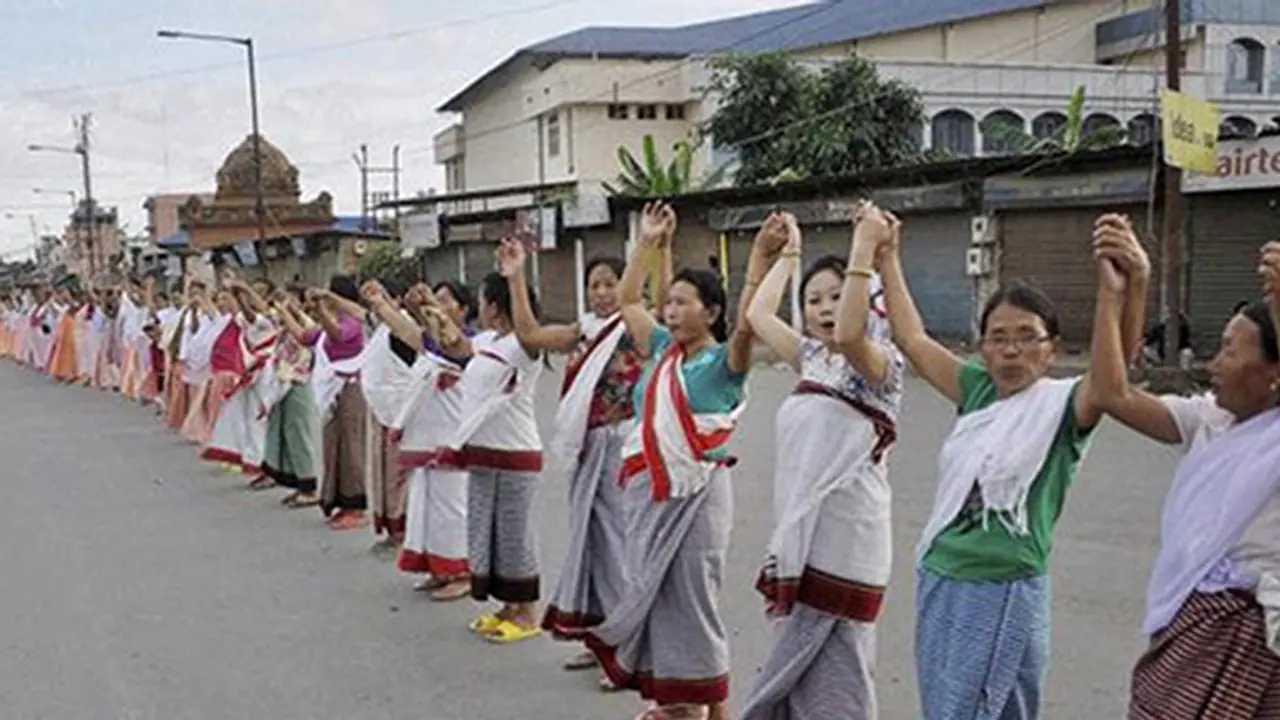Summers in Manipur invariably triggers protests that fester and gets blown up paralysing daily life but the people there seem to have gotten used to this pattern. It hardly ever bothers Delhi, and the rest of the country is either disinterested or ignorant.

This summer the demand for Inner Line Permit (ILP) has returned to haunt the streets of Imphal valley. The permit is a colonial system barring entry into certain restricted areas that served British commercial interests. That has given away to its Indian version; barring entry to ‘outsiders’, a word that has infiltrated into the popular lexicon across the region, giving rise to several sub-national assertions often very violent.
The visual imagery of burning tyres on roads, effigies, rows of women in protest, the men behind them and now school children placed on the frontlines makes for a strong case except that nobody is perturbed. Despite a by protestors when he stepped out to buy flowers and fruits for his daughter’s birthday. The protestors have been harassing residents in every possible way and the government predictably has just looked the other way.
A throwback to last year when the government had passed three bills assuaging the valley protestors on the same issue but sparking counter protests in Kuki areas where nine people died in police firing. In the most bizarre assertion of demand to withdraw the bills, all the nine bodies are still lying in a morgue in Churachandpur. Delhi did make efforts to bury them, and the issue but the people are adamant. The dead are being bartered.
Manipur will elect a new government in 2017, and this summer is significant for the ambitious BJP and an intractable Ibobi Singh leading the Congress government in the state. The so-called civil society movement has now spiked their demand saying no ‘outsiders’ can vote in the coming elections, and that is totally unconstitutional. To add to it, a photograph that has gone viral reinforces the suspicion that the valley’s strongest militia United National Liberation Front (UNLF) maybe behind the protests. The UNLF has been trying to use innovative methods to percolate into the system; in 2012 we had stumbled upon their unique poverty alleviation scheme called Phunga Marup- a microfinance scheme for small and rural entrepreneurs especially women, innovatively fusing their agenda into the mainstream and enlisting sympathisers.
For the uninitiated this plot may appear macabre, but Manipur can hardly be demystified; its contested histories, its multi-ethnic character, dozens of armed separatist outfits, its geopolitics, the lucre of drugs and arms and an inept government operating a deeply corrupt system play out in everyday lives of people. They resent it yet they are almost part of it.
For the sake of convenience let’s assume there are three Manipurs; the populated Imphal valley, the hills where tribes like Thangkuls reside and the stretch where Kukis dominate. The problems and demands in all these three areas are different, but they overlap because it is a territorial battle. Each part has armed groups operating, and they can be lethal.
For the sake of convenience let’s assume there are three Manipurs ; the populated Imphal valley, the hills where tribes like Thangkuls reside and the stretch where Kukis dominate. The problems and demands in all these three areas are different, but they overlap because it is a territorial battle. Each part has armed groups operating, and they can be lethal.
In 2015 I was part of a committee to assess the security situation of Manipur, a report I suppose will never be revealed. While speaking to people and the government and travelling across the state, one felt certain unease; on one hand things looked improved but on the other there was a palpable discontent simmering somewhere, and the look of things was too cosmetic. In a few months after this visit, Imphal imploded.
The most salient feature that I underlined in the exercise was the legitimacy of the state has been totally compromised. There was 0.9% conviction in insurgency-related cases whereas a scary 4% in high criminal cases. There is a pathology in policing with low motivation, rampant corruption and 34000 vacant posts. One noticed a complete breakdown in communication between the various communities. According to the chief secretary the state has two lakh-educated unemployed. The list is endless.
One cannot predict the duration of the current protest but this has no easy answers, and the Congress won’t stick its neck out, nor will the BJP find it easy with the Naga People’s Front (NPF) as their political ally. The newly appointed convener of BJP’s regional alliance, however, clarified that the alliance is applicable only in Nagaland clearly to leave the doors open in Manipur and perhaps use this summer to kick off a dirty campaign. The centre must now intervene without political baggage and ensure that some semblance of normal life is restored, and constitutional provisions are invoked.
Kishalay Bhattacharjee is a senior journalist and author. His most recent book is Blood on my Hands: Confessions of Staged Encounters (Harper Collins 2015). The views expressed here are his own.
